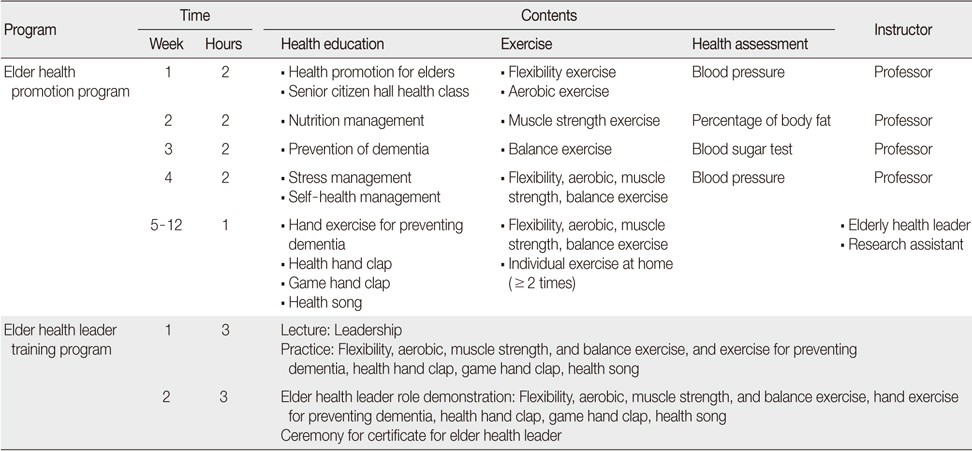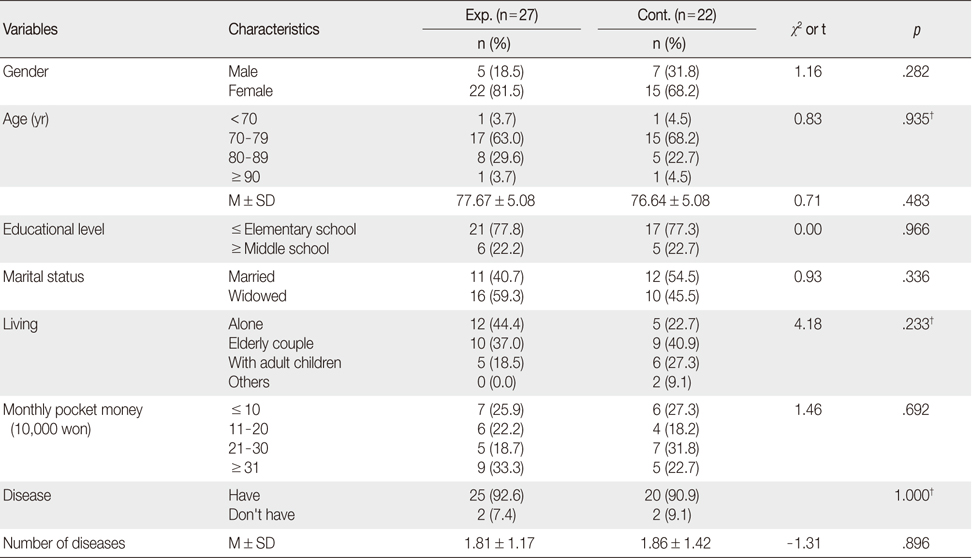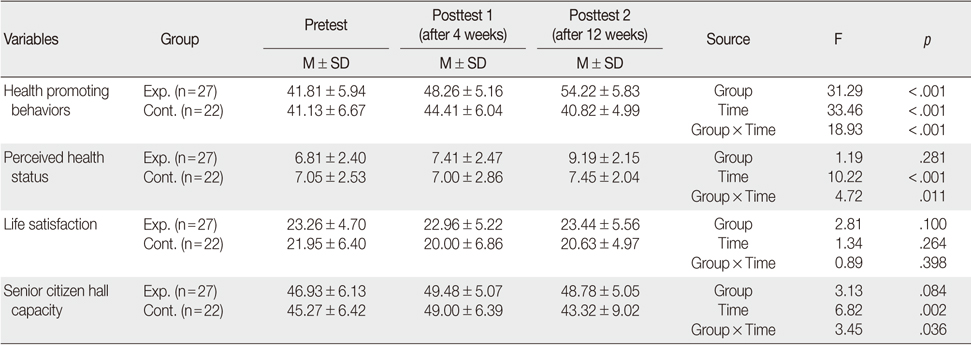Articles
- Page Path
- HOME > J Korean Acad Nurs > Volume 42(1); 2012 > Article
-
Original Article
- Effects of an Elder Health Promotion Program using the Strategy of Elder Health Leader Training in Senior Citizen Halls
- Mee Ock Gu, Young Eun, Eun Sim Kim, Hwang Ran Ahn, In Soo Kwon, Hyun Sook Oh, Young-Sil Kang, Myun Sook Jung, So Young Choi, Kyung Mi Sung, Hye Yeon Kang
-
Journal of Korean Academy of Nursing 2012;42(1):125-135.
DOI: https://doi.org/10.4040/jkan.2012.42.1.125
Published online: February 29, 2012
1Professor, College of Nursing, Gerontological Health Research Center, Institute of Health Sciences, Gyeongsang National University, JinJu, Korea.
2Associate Professor, College of Nursing, Gerontological Health Research Center, Institute of Health Sciences, Gyeongsang National University, JinJu, Korea.
3Assitant Professor, College of Nursing, Gerontological Health Research Center, Institute of Health Sciences, Gyeongsang National University, JinJu, Korea.
4Doctoral student, College of Nursing, Gyeongsang National University, JinJu, Korea.
- Address reprint requests to: Eun, Young. College of Nursing, Gerontological Health Research Center, Institute of Health Sciences, Gyeongsang National University, 92 Chilam-dong, JinJu 660-751, Korea. Tel: +82-55-772-8233, Fax: +82-55-772-8209, yyoeun@gnu.ac.kr
© 2012 Korean Society of Nursing Science
- 822 Views
- 2 Download
- 11 Crossref
Abstract
-
Purpose
- This study was conducted to develop and test the effects of an elder health promotion program and apply strategies for elder health leader training sessions with elders at senior citizen halls.
-
Methods
- A nonequivalent control group pretest-posttest design was used. Participants were 49 elders at a senior citizen hall (intervention: 27, control: 22). The elder health promotion program consisted of health education and exercise. A professional leader led the program for 4 weeks, and then an elder health leader and research assistant led for 8 weeks (total 12 weeks). Scales for elder health promoting behaviors, perceived health status, life satisfaction and senior citizen hall capability were used and physical fitness levels were measured. Data were collected between April 21 and July 28, 2010 and analyzed using Chi-square, Fisher's exact test, t-test, and repeated measure ANOVA with SPSS/WIN 12.0.
-
Results
- Health promoting behaviors, physical fitness, perceived health status, and senior citizen hall capacity were significantly better in the experimental group after the intervention compared to the control group.
-
Conclusion
- Study findings indicate that elder health promotion programs applying strategies of elder health leader training are effective and can be recommended as nursing interventions for health promotion of these elders.
- 1. Bandura A. Social foundations of thought and action: A social cognitive theory. 1986;Englewood Cliffs, NJ, Prentice Hall.
- 2. Brykczynski K. Health contracting. Nurse Practitioner. 1982;7(5):27–31.ArticlePubMed
- 3. Chaskin R.J., Brown P., Venkatesh S., Vidal A. Building community capacity. 2001;New york, NY, Aldin De Gruyter.
- 4. Cho B.H., Jung M.S., Min S.H. Health promotion and community capacity. Korean Journal of Public Health. 2007;44:95–112.
- 5. Choe M.A., Jeon M.Y., Chae Y.R., Choo J.A. An analysis of exercise intervention studies published in major Korean nursing journal. Journal of Korean Biological Nursing Science. 2006;8(1):61–81.
- 6. Choi E.Y., Kim J.Y., Kim H.S. The correlation study on health-promoting behavior, life satisfaction and family support of elderly people. Journal of Korean Gerontological Nursing. 2003;5:7–16.
- 7. Choi S.H. The effect of exercise program on health of the elderly in senior citizen's center. Journal of Korea Community Health Nursing Academic Society. 1997;11(2):38–56.
- 8. Choi S.J. The study of developing senile life satisfaction inventory. Journal of Korean Culture Research Institute. 1986;49:233–258.
- 9. Chon M.Y. The effects of comprehensive healthy management program on health promotion for the elderly. Journal of the Korea Gerontological Society. 2003;23(3):1–13.
- 10. Eun Y., Gu M.O., Kim E.S., Kang Y.S. A comparative study of the health state and need of health-related service between elderly attending the senior welfare center and elderly attending the senior citizens' club. Journal of the Korea Gerontological Society. 2001;3:7–21.
- 11. Eun Y., Kang Y.S., Kim E.S., Kwon I.S., Oh H.S., Gu M.O. The evaluation of a program to promote healthy joints in older adults residing in the community. Journal of Korean Academy of Fundamentals of Nursing. 2005;12:171–179.
- 12. Faul F., Erdfelder E., Lang A.G., Buchner A. Statistical power analyses using G*Power 31: Tests for correlation and regression analyses. Behavior Research Methods. 2009;41:1149–1160.ArticlePubMedPDF
- 13. Gu M.O., Jeon M.Y., Eun Y. The development and effect of an tailored falls prevention exercise for older adults. Journal of Korean Academy of Nursing. 2006;36:341–352.ArticlePubMedPDF
- 14. Gu M.O., Kang Y.S., Kim E.S., Ahn H.L., Oh H.S., Eun Y. The evaluation of a health promotion program for the community residentolder adults. Journal of Korean Academy of Nursing. 2002;32:384–394.ArticlePDF
- 15. Han K.S. Developing recreational exercise programs for the institutionalized elders. Journal of Leisure and Recreation Studies. 2007;8(2):19–29.
- 16. Han Y.S., Choi J.H. Effects of recreation combined exercise program on physical strength for elderly women. Journal of the Korean Gerontological Society. 2008;28:941–952.
- 17. Han Y.S., Kim W.O., Hyun K.S., Won J.S., Kim K.B. The effects of a health promotion program for elderly. Journal of Korean Academy of Nursing. 2005;35:1054–1062.ArticlePubMedPDF
- 18. 2010 statistical analysis of medical cost in Korea. Health Insurance Review & Assessment Service. 2010;Retrieved February 21, 2011. from http://www.hira.or.kr/intro.jsp.
- 19. Jung M.S. Influences of social capital on collective health status from the perspective of community capacity: A case study of health effects of voluntary organizations networks in Dobong-gu community. 2007;Seoul, Graduate School of Public Health, Seoul National University. Unpublished master's thesis.
- 20. Kim H.S. The development and effects of community health promotion project for the farmers cultivating garlic: The application of self efficacy theory and community capacity theory. 2010;Jinju, Gyeongsang National University. Unpublished doctoral dissertation.
- 21. Kim H.S., Park W.Y. Senior fitness test manual. 2005;Seoul, Daehanmedia.
- 22. Lorig K., Holman H., Sobel D., Laurent D., Gonzalez V., Minor M. Living a healthy life with chronic conditions. 2006;3rd ed. Boulder, CO, Bull Publishing Company.
- 23. 2010 current status of elderly welfare. Ministry of Health & Welfare. 2010;Retrieved February 22, 2011. from http://stat.mw.go.kr.
- 24. Oak J.S., Park W.Y. Effects of resistance training on fitness andequilibrium sensory function in old adults. Exercise Science. 2004;13:101–112.
- 25. Rim C.S. Development of community resources for revitalization of respect-for-ageds house. Journal of Welfare for the Aged. 2001;11:29–52.
- 26. Rim C.S., Kim K.H., Kim M.S., Lee K.H., Lee I.S. A study on current status and future aspects of the senior citizen halls in Seoul. Journal of Welfare for the Aged. 2006;31:313–343.
- 27. Shin H.S. Self-esteem, health status and life satisfaction in elderly women according to the spouse's perspective. Journal of Korean Academy of Nursing. 2001;31:1119–1128.ArticlePDF
- 28. Speake D.L., Cowart M.E., Pellet K. Health perceptions and lifestyles of the elderly. Research in Nursing and Health. 1989;12:93–100.ArticlePubMed
- 29. Population projection data. Statistics Korea. 2006;Retrieved February 21, 2011. from http://kostat.go.kr/.
- 30. Yoo S.H. Exploring ways toward development of kyungrodang: Focusing on the characteristics of the elderly based on the types of kyungrodang participation. Journal of the Korean Gerontological Society. 2009;29:1463–1478.
REFERENCES
Figure & Data
REFERENCES
Citations

- Effects of Integrated Dementia Managing Programme for the Elderly with Mild Dementia in Nursing Home
Meung Sook Ahn, Hyun Sook Jo
Journal of Korean Academy of Community Health Nursing.2019; 30(4): 550. CrossRef - The Effects of a Health Mentoring Program in Community-dwelling Vulnerable Elderly Individuals with Diabetes
Ki wol Sung, Hye Seung Kang, Ji Ran Nam, Mi Kyung Park, Ji Hyeon Park
Journal of Korean Academy of Nursing.2018; 48(2): 182. CrossRef - Effects of a Health Promotion Empowerment Program Using a Resident Volunteer as a Lay Health Leader on Frail Elders' Health and Empowerment
Jeong Sook Park, Yun Jung Oh
Journal of Korean Academy of Community Health Nursing.2018; 29(3): 335. CrossRef - Effects of Peer Mentoring Program on the Health Conservation in Elderly Women with Osteoarthritis
Jiran Nam, Kiwol Sung
Journal of Korean Academy of Community Health Nursing.2017; 28(3): 227. CrossRef - Effects of Exercise Program for Women of Old-Old Age in Senior Citizen Halls based on Pender's Health Promotion Model
Kyoung Im Lee, Young Eun
Journal of muscle and joint health.2016; 23(2): 71. CrossRef - Analysis on Characteristics of Indoor Environment and Satisfaction Level of Users of Senior Centers in Jeonju Residential Areas
Insoo Jeoong, Xiangwei Meng
Journal of the Korean Housing Association.2016; 27(6): 31. CrossRef - Factors Influencing Physical Activity in Elderly Women at Senior Citizen Centers
Kyung Hee Seo, Young Eun
Journal of muscle and joint health.2015; 22(3): 236. CrossRef - Developing a Community Capacity Builded Exercise Maintenance Program for Frail Elderly Women
Yeon Hee Choi, Sun Yi Hong
The Korean Journal of Rehabilitation Nursing.2015; 18(2): 153. CrossRef - A Comparative Study on Influencing Factors of Health Related Quality of Life of the Elderly in Senior Center by Region : Focus on Urban and Rural Areas
Soon-Ok Yang, Hae-Ryun Cho, Seung-Hee Lee
The Journal of Digital Policy and Management.2014; 12(1): 501. CrossRef - The Relationships between Social Determinants of Health and Health-related Quality of Life among the Community-dwelling Elderly
Junghee Kim, Hyeonkyeong Lee, Chung Yul Lee, Eunhee Cho
Journal of Korean Academy of Community Health Nursing.2014; 25(4): 237. CrossRef - The Effects of an Exercise Program using a Resident Volunteer as a Lay Health Leader for Elders' Physical Fitness, Cognitive Function, Depression, and Quality of Life
Yeon-Hee Choi, Na-Young Kim
Journal of Korean Academy of Community Health Nursing.2013; 24(3): 346. CrossRef
Elder Health Promotion Program and Elder Health Leader Training
Homogeneity Test of General Characteristics between Experimental and Control Groups (N=49)
†Fisher's exact test.
Exp.=Experimental group; Cont.=Control group.
Homogeneity Test of Dependent Variables between Experimental and Control Groups (N=49)
Exp.=Experimental group; Cont.=Control group.
Effects of Program on Health Promoting Behaviors, Perceived Health Status, Life Satisfaction, Senior Citizen Hall Capacity (N=49)
Exp.=Experimental group; Cont.=Control group.
Effects of Program on Physical Fitness (N=49)
Exp.=Experimental group; Cont.=Control group.
†Fisher's exact test. Exp.=Experimental group; Cont.=Control group.
Exp.=Experimental group; Cont.=Control group.
Exp.=Experimental group; Cont.=Control group.
Exp.=Experimental group; Cont.=Control group.
 KSNS
KSNS
 E-SUBMISSION
E-SUBMISSION





 Cite
Cite

